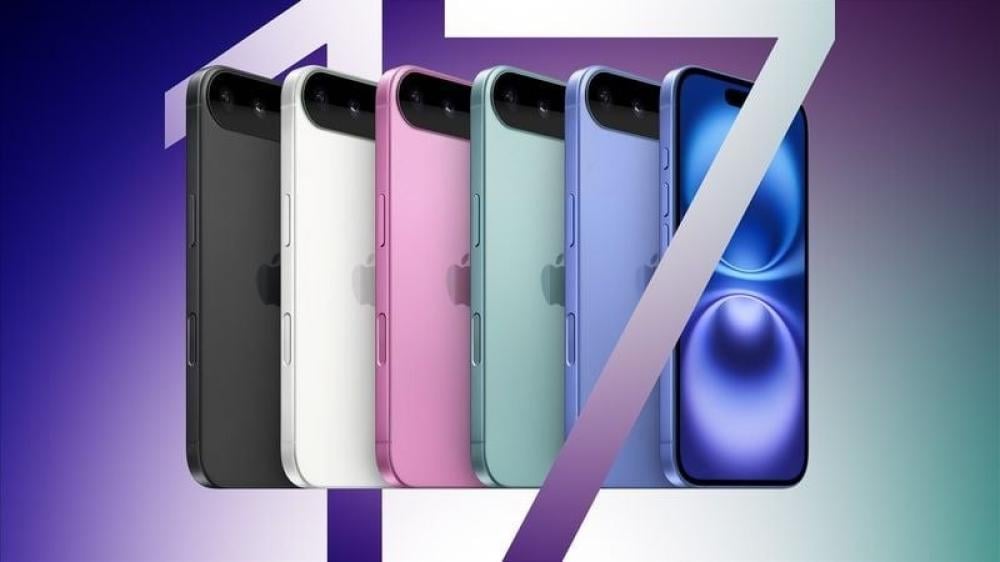The year 2025 could be a major turning point in the history of the iPhone, as leaks indicate that Apple is preparing to unveil its biggest update since the launch of the iPhone X in 2017. This change is an all-new version called the iPhone 17 Air , which will feature a thinner design, a different screen size, and improvements to the camera and other notable specifications.
Four new versions without "Plus"
Apple plans to launch only four versions of the iPhone 17:
- iPhone 17
- iPhone 17 Pro
- iPhone 17 Pro Max
- The all-new iPhone 17 Air
What's noteworthy here is that the company will abandon the Plus version altogether due to weak user demand. The iPhone 17 Air will serve as an alternative option in the mid-range category, but it's not a direct replacement for the Plus.
New location for "Air" among the family
The iPhone 17 Air is expected to feature a 6.6-inch display and a body measuring just 6mm thick, making it the thinnest iPhone ever. Compared to Apple's other iPhone lineups like the MacBook and iPad , the iPhone 17 Air will be the equivalent of the MacBook Air and iPad Air , while the higher-spec Pro models will remain the MacBook Pro and iPad Pro .
While the iPhone 17 Pro and Pro Max will maintain their screen sizes at 6.3 inches and 6.9 inches , respectively (as in the current iPhone 16 Pro), the Air will fall between the two in terms of size. The regular iPhone 17 will have a larger screen, up from 6.1 inches, to 6.3 inches, the same size as the Pro.
iPhone 17 Air Pricing
Some early leaks suggested the iPhone 17 Air might be more expensive than the iPhone 17 Pro Max, but more recent news confirms it will be a mid-priced option :
- Higher than the price of the iPhone 17.
- Less than the price of the iPhone 17 Pro and Pro Max.
It is thus an indirect replacement for the old Plus category, but with a completely different design touch and experience.
ProMotion screen updates
The most notable surprise is that all iPhone 17 models (not just the Pro models) will support ProMotion displays with a refresh rate of up to 120Hz , which means smoother scrolling and a better video viewing experience. This change was made possible by Apple's adoption of LTPO OLED displays across all models.
Always-On Display technology is also possible with LTPO displays, but it is not yet clear whether it will reach all versions or remain exclusive to the Pro versions.
Changes in materials and exterior design
For the Pro models, there are speculations that Apple may replace the titanium frame with aluminum to enhance durability and reduce cost, while adopting a glass-and-aluminum design for the back. Another notable change is the transition from the current square camera shape to a horizontal, rectangular camera bar , which we may also see in the iPhone 17 Air.
Camera updates
- Selfie camera : Upgraded to 24MP with a six-element lens.
- Pro Max : 48MP telephoto camera instead of the current 12MP.
- iPhone 17 Air : 48MP single-lens rear camera.
- Regular iPhone 17 : Will retain the same Wide and Ultra Wide cameras without major changes.
SIM cards and network technologies
One version of the iPhone 17 (most likely the iPhone 17 Air) is expected to feature an Apple-designed Wi-Fi 7 chip instead of one from Broadcom. Apple is also testing the use of its own 5G modem in this particular device, replacing Qualcomm's, while the other versions will continue to rely on Qualcomm chips.
iPhone 17 accessories
Apple is currently designing new cases called TechWoven as a replacement for the previous FineWoven cases, with improvements in durability and material quality.
The new cases are expected to feature small openings at the bottom corners that allow for a lanyard or crossbody strap to be attached, as well as improved metal buttons with a more responsive touch, and support for the MagSafe feature.
Expected colors include: black, green, blue, purple, and orange.
Apple also plans to launch a new side strap with an innovative magnetic attachment mechanism.
Cooling improvements
The higher-end iPhone 17 Pro models will adopt vapor chamber cooling technology to ensure stable performance and reduce overheating, especially with the power of the new A19 processor.
There is a possibility that this technology will extend to all versions of the iPhone 17.
Screen specifications
- All versions will feature Samsung OLED displays, the same panel used in the iPhone 16 Pro, but 30% brighter and longer-lasting.
- The Pro versions were expected to feature a scratch-resistant, less reflective glass, but Apple appears to have struggled with mass production, which could delay this feature.
ProMotion and Always-On feature
- Starting in 2025, the 120Hz ProMotion feature will be available on all models, not just the Pro versions.
- All devices will be based on LTPO displays that allow for a change in refresh rate between 1Hz and 120Hz to save power and support smoothness.
- The Always-On feature may also expand to all versions, but this has not been decided yet.
The therapist
- All versions will get the A19 processor built on TSMC's 3nm (3NP) process, with improved efficiency and transistor density.
- The Pro versions will come with the A19 Pro processor, while the Air version may get either the regular A19 or a toned-down version of the A19 Pro.
Random Access Memory (RAM)
- iPhone 17 Pro, Pro Max, and Air: 12GB RAM
- Regular iPhone 17: 8GB RAM
New 5G modem
- The iPhone 17 Air will be the first to use an Apple-designed 5G modem instead of Qualcomm's.
- The theoretical download speed will reach 4Gbps , but it will lack mmWave support and be limited to sub-6GHz networks.
SIM card
- Apple will ditch the traditional SIM slot in more countries, having started in the United States with the iPhone 14.
- The iPhone 17 Air in particular will not include a SIM slot at all due to its slim design.
Connectivity: Wi-Fi and Bluetooth
- All versions will feature the first Apple-designed Wi-Fi chip with Wi-Fi 7 support.
- Wi-Fi 7 enables speeds exceeding 40Gbps with reduced latency, by operating on the 2.4GHz, 5GHz, and 6GHz bands simultaneously.
- Bluetooth 5.3 support will continue.
Battery and charging
- All versions will use a new adhesive to make battery replacement easier, as was the case with the iPhone 16 and 16 Plus.
- Supports wireless charging via the Qi 2.2 standard with a capacity of up to 25W with certified chargers (compared to 15W currently).
- Pro versions may get reverse wireless charging to charge AirPods and Apple Watch directly from the phone.
camera
- All versions: Improved 24MP front camera (up from 12MP) with significant improvements in image quality.
- iPhone 17 Pro Max:
- 48MP Wide Main Camera
- 48MP Ultra-Wide Camera
- 48MP Telephoto Tetraprism Camera with 8K video recording support for the first time
- iPhone 17 Air: 48MP single rear camera.
- Regular iPhone 17: Dual system (Wide + Ultra-Wide).
- Pro versions may come with a variable aperture feature that allows control of depth of field and lighting, in addition to the dual video recording feature using the front and rear cameras at the same time.
Expected prices
- iPhone 17 Air: Starting at $899 (equivalent to the iPhone 16 Plus).
- Reports indicate that the prices of the remaining versions may increase by approximately $50 due to higher component costs.
Release date
- Apple's next event will be on Tuesday, September 9, 2025 (10 AM California Time).
- Pre-order opens: September 12th .
- Official release in stores: September 19 .
What's next for iPhone 17?
- Starting in 2026, Apple will split its iPhone launches between the fall and spring seasons :
- Fall 2026: iPhone 18 Air, iPhone 18 Pro, and Pro Max, along with the first foldable iPhone , will be launched.
- Spring 2027: Launch of the regular iPhone 18 and iPhone 18e.
- The iPhone 18 Pro may feature under-display Face ID with a smaller Dynamic Island, and later in 2027, we may see the first iPhone with an all-screen display.
- The foldable iPhone will feature a high-quality hinge to reduce creases and a smoother design.
- Variable aperture lenses will bring your camera closer to the DSLR experience.
- New C2 Modem chip with better power support and mmWave 5G.
- The A20 processor is built on 2nm technology, for a remarkable performance advantage.
- A futuristic 200MP rear camera for enhanced detail and image resolution, to rival Samsung's flagship phones.

